Tungsten Carbide Step Drill bits Ⅴ
- Details
- Category: Tungsten Information
- Published on Wednesday, 18 November 2015 15:50
In last part we know that to start drilling with a smaller tungsten carbide step drill bit, it’s necessary to prepare a center mark on workpiece and apply cooling fluid. In this part we go on explain how to use a tungsten carbide step drill bit.
Step 5: release the chuck of the drill motor to remove the small tungsten carbide step drill bit. Secure the large step drill bit into the chuck of the drill motor. Insert the small tip of the large step drill bit into the hole you created in the metal. Apply cutting and tapping fluid onto the large step drill bit and around the hole in the metal.
Step 6: depress the trigger of the drill motor to run the large-diameter step drill bit into the hole. Stop drilling frequently to apply additional cutting and tapping fluid to the drill bit. Stop drilling when the hole has reached the desired diameter.
Step 7: remove the large tungsten carbide step drill bit from the drill motor. Clean both step drill bits with a rag to remove metal shavings from the bits. Clean the metal shavings from around the hole that you drilled in the metal. Store the drill bits in a tool box or drill bit container to avoid dropping them or otherwise damaging them.
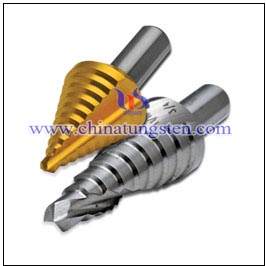
(The end-This article is divided into 5 parts. Here is part 5. For part 4, please refer to http://news.chinatungsten.com/en/tungsten-information/80510-ti-10404)
| Tungsten Carbide Supplier: Chinatungsten Online tungsten-carbide.com.cn | Tel.: 86 592 5129696; Fax: 86 592 5129797;Email:sales@chinatungsten.com |
| Tungsten News&Tungsten Prices, 3G Version: http://3g.chinatungsten.com | Molybdenum News & Molybdenum Price: http://news.molybdenum.com.cn |
Tungsten Carbide Step Drill bits Ⅳ
- Details
- Category: Tungsten Information
- Published on Wednesday, 18 November 2015 15:48
In last part we know that tungsten carbide step drill bits are also ideal for electrical work, such as chassis and front panels, and can be used to debur holes, but may at the same time cause bur on the a hole’s back side. In this part we talk about how to use a tungsten carbide step drill bit.
To use a tungsten carbide step drill bit, it is suggested to following the below steps.
Step 1: put on appropriate eye protection (safety glasses or goggles).
Step 2: place the tip of the center punch on the metal to be drilled at the location of the desired hole. Hit the blunt end of the center punch with the hammer to leave an indentation (referred to as a center mark). This indentation will provide a place for the tungsten carbide step drill bit to "catch", so it doesn't drift to the wrong location on the work.
Step 3: secure the self-starting step drill bit into the chuck of the drill motor. Apply cutting and tapping fluid to the center mark and the step drill bit.
Step 4: align the tip of the self-starting step drill bit with the center mark on the metal's surface. Depress the drill's trigger to start drilling the hole. Run the small step drill bit completely through the metal. Apply additional cutting and tapping fluid as necessary to keep the step drill bit cool.
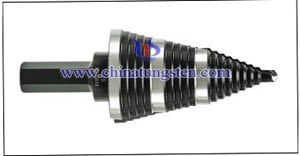
(To be continued. This article is divided into 5 parts. Here is part 4. For part 3, please refer to http://news.chinatungsten.com/en/tungsten-information/80509-ti-10402; for part 5, please refer to http://news.chinatungsten.com/en/tungsten-information/80511-ti-10405)
| Tungsten Carbide Supplier: Chinatungsten Online tungsten-carbide.com.cn | Tel.: 86 592 5129696; Fax: 86 592 5129797;Email:sales@chinatungsten.com |
| Tungsten News&Tungsten Prices, 3G Version: http://3g.chinatungsten.com | Molybdenum News & Molybdenum Price: http://news.molybdenum.com.cn |
Tungsten Carbide Step Drill bits Ⅲ
- Details
- Category: Tungsten Information
- Published on Wednesday, 18 November 2015 15:46
In last part we know that tungsten carbide step drill bits can drill an entire range of holes usually on softer material or sheet metal less than 1/4 inch thick. In this part we talk about the usage and advantage of this kind of bit.
Tungsten carbide step drill bits are ideal for use in electrical work where thin steel, aluminum or plastic boxes and chassis are encountered. The short length of the step drill bit and ability to vary the diameter of the finished hole is an advantage in chassis or front panel work. The finished hole can often be made quite smooth and burr-free, especially in plastic.
An additional use of tungsten carbide step drill bits is deburring holes left by other bits, as the sharp increase to the next step size allows the cutting edge to scrape burrs off the entry surface of the workpiece. However, the straight flute is poor at chip ejection, and can cause a burr to be formed on the exit side of the hole, more so than a spiral twist drill bit turning at high speed.
The step drill bit was invented by Harry C. Oakes and patented in 1973. It was sold only by the Unibit Corporation in the 1980s until the patent expired, and was later sold by other companies.
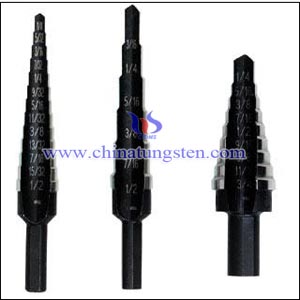
(To be continued. This article is divided into 5 parts. Here is part 3. For part 2, please refer to http://news.chinatungsten.com/en/tungsten-information/80508-ti-10401; for part 4, please refer to http://news.chinatungsten.com/en/tungsten-information/80510-ti-10404)
| Tungsten Carbide Supplier: Chinatungsten Online tungsten-carbide.com.cn | Tel.: 86 592 5129696; Fax: 86 592 5129797;Email:sales@chinatungsten.com |
| Tungsten News&Tungsten Prices, 3G Version: http://3g.chinatungsten.com | Molybdenum News & Molybdenum Price: http://news.molybdenum.com.cn |
Tungsten Carbide Step Drill bitsⅡ
- Details
- Category: Tungsten Information
- Published on Wednesday, 18 November 2015 15:43
In last part we know that a tungsten carbide step drill bit (unibit) is a conical bit for hole enlarging with straight or angled transitions from smaller to larger diameters. Smaller ones are self-starting, while larger ones need a predrilled hole. This part we talk about the advantage of and suitable work piece materials for a step drill bit.
The advantage to the tungsten carbide step drill bit is that both diameters have the same flute characteristics, which keeps the bit from clogging when drilling in softer materials, such as aluminum; in contrast, a drill bit with a slip-on collar does not have the same benefit.
One tungsten carbide step drill bit can drill the entire range of holes necessary on a countertop, speeding up installation of fixtures. They are most commonly used on softer materials, such as plywood, particle board, drywall, acrylic, laminate and in general construction. They can be used on very thin sheet metal, such as metal sheet up to 1/4 of an inch thick, but metals tend to cause premature bit wear and dulling.
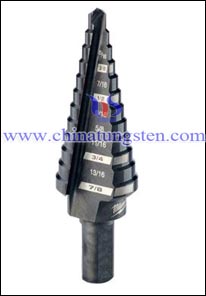
(To be continued. This article is divided into 5 parts. Here is part 2. For part 1, please refer to http://news.chinatungsten.com/en/tungsten-information/80507-ti-10400; for part 3, please refer to http://news.chinatungsten.com/en/tungsten-information/80509-ti-10402)
| Tungsten Carbide Supplier: Chinatungsten Online tungsten-carbide.com.cn | Tel.: 86 592 5129696; Fax: 86 592 5129797;Email:sales@chinatungsten.com |
| Tungsten News&Tungsten Prices, 3G Version: http://3g.chinatungsten.com | Molybdenum News & Molybdenum Price: http://news.molybdenum.com.cn |
Tungsten Carbide Step Drill bitsⅠ
- Details
- Category: Tungsten Information
- Published on Wednesday, 18 November 2015 15:41
A tungsten carbide step drill bit, also called unibit, is a roughly conical bit with a stairstep profile. It is a drill bit that has the tip ground down to a different diameter. Each step on the bit is larger in diameter than the step before. The transition between this ground diameter and the original diameter is either straight, to form a counterbore, or angled, to form a countersink. Due to its design, a single bit can be used for drilling a wide range of hole sizes.
Smaller tungsten step drill bits are self-starting and no pilot bit is required to start the hole. On larger step drill bits, you need to have a hole pre-drilled that is equal in diameter to the smallest step on the bit. The larger-size bits have blunt tips and are used for hole enlarging. Most of these bits are custom-made for each application, which makes them more expensive.
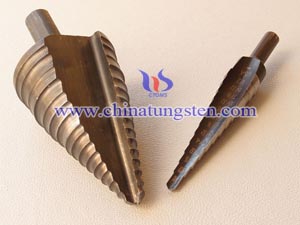
(To be continued. This article is divided into 5 parts. Here is part 1. For part 2, please refer to http://news.chinatungsten.com/en/tungsten-information/80508-ti-10401)
| Tungsten Carbide Supplier: Chinatungsten Online tungsten-carbide.com.cn | Tel.: 86 592 5129696; Fax: 86 592 5129797;Email:sales@chinatungsten.com |
| Tungsten News&Tungsten Prices, 3G Version: http://3g.chinatungsten.com | Molybdenum News & Molybdenum Price: http://news.molybdenum.com.cn |
Tungsten Carbide Spade BitsⅡ
- Details
- Category: Tungsten Information
- Published on Tuesday, 17 November 2015 16:35

(The End-This article is divided into 2 parts. Here is part 2. For part 1, please refer to http://news.chinatungsten.com/en/tungsten-information/80455-ti-10388)
| Tungsten Carbide Supplier: Chinatungsten Online tungsten-carbide.com.cn | Tel.: 86 592 5129696; Fax: 86 592 5129797;Email:sales@chinatungsten.com |
| Tungsten News&Tungsten Prices, 3G Version: http://3g.chinatungsten.com | Molybdenum News & Molybdenum Price: http://news.molybdenum.com.cn |
Tungsten Carbide Spade BitsⅠ
- Details
- Category: Tungsten Information
- Published on Tuesday, 17 November 2015 16:33

(To be continued. This article is divided into 2 parts. Here is part 1. For part 2, please refer to http://news.chinatungsten.com/en/tungsten-information/80456-ti-10389)
| Tungsten Carbide Supplier: Chinatungsten Online tungsten-carbide.com.cn | Tel.: 86 592 5129696; Fax: 86 592 5129797;Email:sales@chinatungsten.com |
| Tungsten News&Tungsten Prices, 3G Version: http://3g.chinatungsten.com | Molybdenum News & Molybdenum Price: http://news.molybdenum.com.cn |
Tips to Use Tungsten Carbide Tile Drill BitsⅡ
- Details
- Category: Tungsten Information
- Published on Tuesday, 17 November 2015 16:30

(The End-This article is divided into 2 parts. Here is part 2. For part 1, please refer to http://news.chinatungsten.com/en/tungsten-information/80453-ti-10386)
| Tungsten Carbide Supplier: Chinatungsten Online tungsten-carbide.com.cn | Tel.: 86 592 5129696; Fax: 86 592 5129797;Email:sales@chinatungsten.com |
| Tungsten News&Tungsten Prices, 3G Version: http://3g.chinatungsten.com | Molybdenum News & Molybdenum Price: http://news.molybdenum.com.cn |
Tips to Use Tungsten Carbide Tile Drill BitsⅠ
- Details
- Category: Tungsten Information
- Published on Tuesday, 17 November 2015 16:28

(To be continued. This article is divided into 2 parts. Here is part 1. For part 2, please refer to http://news.chinatungsten.com/en/tungsten-information/80454-ti-10387)
| Tungsten Carbide Supplier: Chinatungsten Online tungsten-carbide.com.cn | Tel.: 86 592 5129696; Fax: 86 592 5129797;Email:sales@chinatungsten.com |
| Tungsten News&Tungsten Prices, 3G Version: http://3g.chinatungsten.com | Molybdenum News & Molybdenum Price: http://news.molybdenum.com.cn |
Tips to Use Tungsten Carbide Wood Plug Cutters
- Details
- Category: Tungsten Information
- Published on Tuesday, 17 November 2015 16:24

| Tungsten Carbide Supplier: Chinatungsten Online tungsten-carbide.com.cn | Tel.: 86 592 5129696; Fax: 86 592 5129797;Email:sales@chinatungsten.com |
| Tungsten News&Tungsten Prices, 3G Version: http://3g.chinatungsten.com | Molybdenum News & Molybdenum Price: http://news.molybdenum.com.cn |



 sales@chinatungsten.com
sales@chinatungsten.com